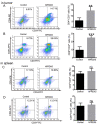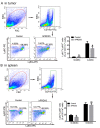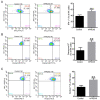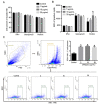The antitumor activity of hPRDX5 against pancreatic cancer and the possible mechanisms
- PMID: 36102418
- PMCID: PMC9467283
- DOI: 10.1590/1414-431X2022e12324
The antitumor activity of hPRDX5 against pancreatic cancer and the possible mechanisms
Abstract
Recombinant human peroxiredoxin-5 (hPRDX5), isolated from anti-cancer bioactive peptide (ACBPs), shows a homology of 89% with goat peroxiredoxin-5 (gPRDX5) and is reported to display anti-tumor activity in vivo. Herein, we explored the effect of hPRDX5 and the responsible mechanism in treating pancreatic cancer. Tumor-bearing mice were randomly divided into normal PBS group and treatment group (n=5; 10 mg/kg hPRDX5). Flow cytometry was employed to examine lymphocytes, myeloid-derived suppressor cell subsets, and the function proteins of natural killer (NK) cells in peripheral blood, spleen, and tumor tissues of mice. Western blot was used to measure the protein expressions of the key nodes in TLR4-MAPK-NF-κB signaling pathway. The rate of tumor suppression was 57.6% at a 10 mg/kg dose in orthotopic transplanted tumor mice. Moreover, the population of CD3+CD4+T cells, NK cells, and CD3+CD8+T cells was significantly increased in the tumor tissue of the hPRDX5 group, while the proportion of granulocytic-myeloid-derived suppressor cells decreased slightly. In addition, after treatment with hPRDX5, the percentage of NK cells in blood increased more than 4-fold. Our findings indicated that hPRDX5 effectively suppressed pancreatic cancer possibly via the TLR4-MAPK-NF-κB signaling cascade; hence hPRDX5 could be a prospective immunotherapy candidate for treating pancreatic cancer.
Figures







Similar articles
-
The antitumor activity and preliminary modeling on the potential mechanism of action of human peroxiredoxin-5.Oncotarget. 2017 Apr 18;8(16):27189-27198. doi: 10.18632/oncotarget.16089. Oncotarget. 2017. PMID: 28423711 Free PMC article.
-
Discovery of hPRDX5-based peptide inhibitors blocking PD-1/PD-L1 interaction through in silico proteolysis and rational design.Cancer Chemother Pharmacol. 2020 Jan;85(1):185-193. doi: 10.1007/s00280-019-03995-z. Epub 2019 Nov 19. Cancer Chemother Pharmacol. 2020. PMID: 31745591
-
Polygonatum sibiricum polysaccharides play anti-cancer effect through TLR4-MAPK/NF-κB signaling pathways.Int J Biol Macromol. 2018 May;111:813-821. doi: 10.1016/j.ijbiomac.2018.01.070. Epub 2018 Jan 16. Int J Biol Macromol. 2018. PMID: 29343453
-
Blocking NF-κB Is Essential for the Immunotherapeutic Effect of Recombinant IL18 in Pancreatic Cancer.Clin Cancer Res. 2016 Dec 1;22(23):5939-5950. doi: 10.1158/1078-0432.CCR-15-1144. Epub 2016 Jun 13. Clin Cancer Res. 2016. PMID: 27297583
-
Baicalin triggers apoptosis, inhibits migration, and enhances anti-tumor immunity in colorectal cancer via TLR4/NF-κB signaling pathway.J Food Biochem. 2022 Mar;46(3):e13703. doi: 10.1111/jfbc.13703. Epub 2021 Mar 20. J Food Biochem. 2022. PMID: 33742464
References
-
- Bellone G, Turletti A, Artusio E, Mareschi K, Carbone A, Tibaudi D, et al. Tumor-associated transforming growth factor-beta and interleukin-10 contribute to a systemic Th2 immune phenotype in pancreatic carcinoma patients. Am J Pathol. 1999;155:537–547. doi: 10.1016/S0002-9440(10)65149-8. - DOI - PMC - PubMed
Publication types
MeSH terms
Substances
LinkOut - more resources
Full Text Sources
Medical
Research Materials

